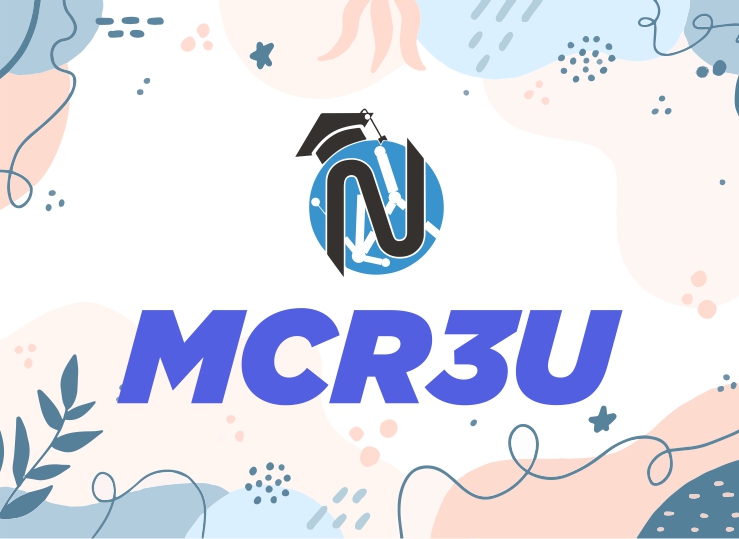
Functions (MCR3U)
Course Description
This course introduces the mathematical concept of function by extending students’ experience with linear and quadratic relations. Students will investigate properties of discrete and continuous functions, including exponential and trigonometric functions; applications of functions; investigate inverse functions; and develop facility in determining equivalent algebraic expressions. Students will reason mathematically and communicate their thinking as they solve multi-step problems.
For Ministry Guideline Click Here
| Units | Descriptions | Length (Approximately) |
|---|---|---|
| 1. | Characteristics of Functions Students will explore the concepts of relations and functions in this unit, their representations, their inverses, and how to make connections between the algebraic and graphical representations of functions using transformations. Students will learn how to apply and determine the different transformations that can be applied to functions using transformational parameters, along with learning to apply function and set notations, and graphing methods consistently. Students will explore properties of functions, in particular by determining the zeros and the maximum or minimum of a quadratic function, and solve problems involving quadratic functions, including problems arising from real-world applications. By the end of the unit, students will be able to demonstrate an understanding of equivalence as it relates to simplifying polynomial, radical, and rational expressions. |
30 hours |
| 2. | Exponential Functions This unit will explore several topics including evaluating powers with rational exponents, simplifying expressions containing exponents, and describing properties of exponential functions represented in a variety of ways. The emphasis will be on modelling and problem solving using these concepts. |
20 hours |
| 3. | Discrete Functions The unit begins with an exploration of recursive sequences and how to represent them in a variety of ways. Making connections to Pascal's triangle, demonstrating understanding of the relationships involved in arithmetic and geometric sequences and series, and solving related problems involving compound interest and ordinary annuities will form the rest of the unit. |
20 hours |
| 4. | Trigonometry This unit concentrates students' attention on determining the values of the trigonometric ratios for angles less than 360° proving simple trigonometric identities and solving problems using the primary trigonometric ratios. The sine law and the cosine law are developed. Students will learn to demonstrate an understanding of periodic relationships and sinusoidal functions, and make connections between the numeric, graphical, and algebraic representations of sinusoidal functions while solving problems involving sinusoidal functions |
30 hours | The final assessment task is to provide students to do Exam Review (4 Hrs) +Formative Exam (2 Hrs) +Culminating Task (2 Hrs) + Final Exam (2 Hrs) | 10 hours |
| Total | 110 hours | |
Overall Curriculum Expectations
By the end of this course, students will:
- demonstrate an understanding of functions, their representations, and their inverses, and make connections between algebraic and graphical representations of functions using transformations
- determine the zeros and the maximum and the minimum of a quadratic function, and solve problems involving quadratic functions, including problems arising from real-world applications
- demonstrate an understanding of equivalence as it relates to simplifying polynomial, radical and rational expressions.
- evaluate powers with rational exponents, simplify expressions containing exponents, and describe properties of exponential functions represented in a variety of ways.
- make connections between numeric, graphical, and algebraic representations of exponential functions
- identify and represent exponential functions, and solve problems involving exponential functions, including problems arising from real-world applications.
- demonstrate an understanding of recursive sequence, represent recursive sequences in a variety of ways, and make connections to Pascal’s triangle.
- demonstrate an understanding of the relationships involved in arithmetic and geometric sequences and series and solve problems.
- make connections between sequences, series, and financial applications, and solve problems involving compound interest and ordinary annuities.
- demonstrate an understanding of recursive sequence, represent recursive sequences in a variety of ways, and make connections to Pascal’s triangle.
- demonstrate an understanding of the relationships involved in arithmetic and geometric sequences and series and solve problems.
- make connections between sequences, series, and financial applications, and solve problems involving compound interest and ordinary annuities.
By the end of this course, students will:
- demonstrate an understanding of functions, their representations, and their inverses, and make connections between algebraic and graphical representations of functions using transformations
- determine the zeros and the maximum and the minimum of a quadratic function, and solve problems involving quadratic functions, including problems arising from real-world applications
- demonstrate an understanding of equivalence as it relates to simplifying polynomial, radical and rational expressions.
- evaluate powers with rational exponents, simplify expressions containing exponents, and describe properties of exponential functions represented in a variety of ways.
- make connections between numeric, graphical, and algebraic representations of exponential functions
- identify and represent exponential functions, and solve problems involving exponential functions, including problems arising from real-world applications.
- demonstrate an understanding of recursive sequence, represent recursive sequences in a variety of ways, and make connections to Pascal’s triangle.
- demonstrate an understanding of the relationships involved in arithmetic and geometric sequences and series and solve problems.
- make connections between sequences, series, and financial applications, and solve problems involving compound interest and ordinary annuities.
- demonstrate an understanding of recursive sequence, represent recursive sequences in a variety of ways, and make connections to Pascal’s triangle.
- demonstrate an understanding of the relationships involved in arithmetic and geometric sequences and series and solve problems.
- make connections between sequences, series, and financial applications, and solve problems involving compound interest and ordinary annuities.
Assessment & Evaluation of student performance
Formative assessments are learning practices that provide important feedback to student progress. Examples include homework and quizzes.
Summative assessments form a foundation for final mark allotment at the end of the unit, term and final evaluation.
An achievement chart will be given to students at regular intervals and the purpose of the charts is to provide feedback to students in relation to content and performance strands.
| Knowledge and understanding | Communication | Thinking Inquiry and Problem solving | Application |
|---|---|---|---|
| 25% | 25% | 25% | 25% |
Unit Tests, Written assignments, presentations, Classroom Observations and Classroom conversations.










